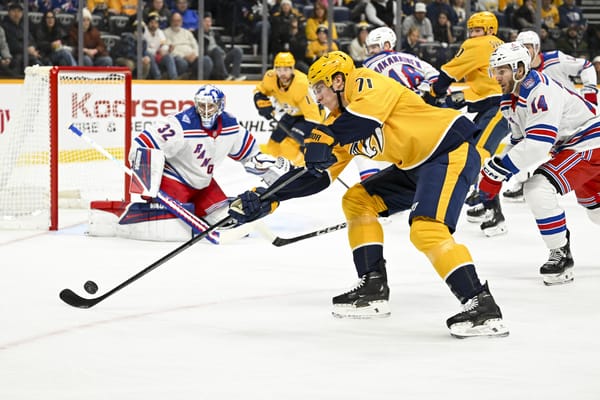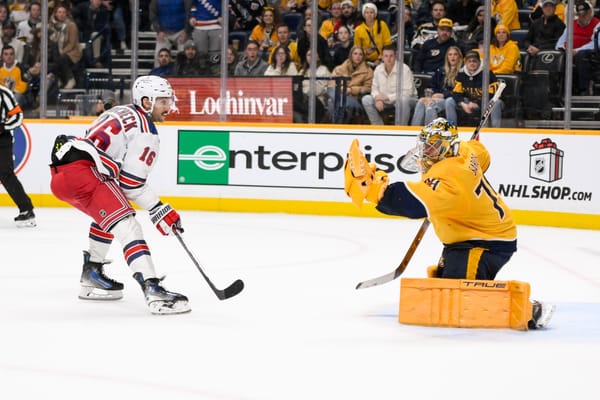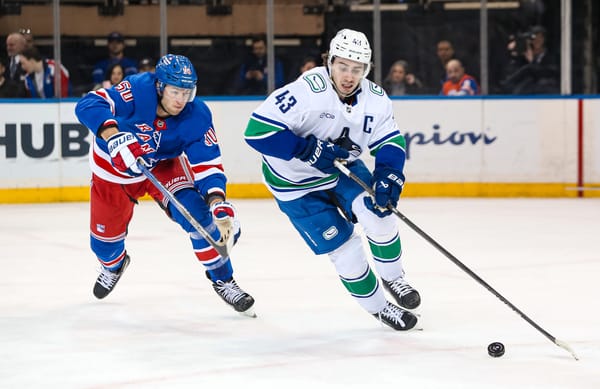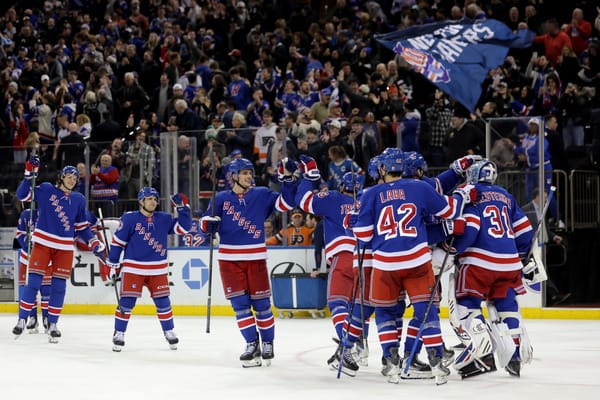July 2016 New York Rangers Prospect Rankings: 10-1
Goaltenders dominate the updated list of the top-ten New York Rangers prospects.
This summer's top-ten is certainly a fresh look. It includes a few new additions, as well as a number of incumbents who have moved up or down quite a bit. Exciting times! You can view players ranked 11-20 here as well as players ranked 21-32 here.
10. Brandon Halverson, Goaltender, 20 Years Old, Second-Round Pick (2014)
Previous Ranking: 5
Halverson was, by all reports, utterly brilliant at Rangers' prospect camp last summer. So much so that the Rangers immediately handed him an entry-level contract. Things got turbulent from there. Halverson suffered a high-ankle sprain in training camp and missed the first part of the OHL season. When he returned, it was clear he wasn't fully engaged either mentally or physically. After going into the season as the slight favorite for the USA's starting netminder spot at the World Junior Championships, he instead backed up Hurricanes prospect Alex Nedjelkovic. As the season went on, Halverson did get better. In particular, he put in mostly good performances for the Sault Ste. Marie Greyhounds during the playoffs, playing a key role in their upset over the Sarnia Sting in the first round.
I'm still processing my thoughts on Halverson. It's very well possible we haven't seen his best yet. He's right in the sweet spot for goaltender size and has the physical tools necessary to be a high-caliber goaltender. His glove hand has become much more stable and proactive instead of reactive over the last two years. A few goaltending specialists I've talked to believe in his potential and think he needs the right coach to help him realize it. Benoit Allaire is never the "wrong" coach, so the conditions are set. For Halverson, it will be the mental side of the game that holds him back if anything. I've been told that he can let minor injuries get to his head and throw off the foundation of his game, for example. He probably has to do a bit of maturing as a person, which is not the big deal that hockey media often makes it out to be.
Halverson still has a high ceiling, and though I am principally against taking goaltender in the first couple of rounds, his output so far has been fine. He's done nothing yet that makes taking him in particular 59th overall look like a bad decision. Though Halverson could technically return to the OHL for his overage year, all signs point towards him turning pro this fall. Whether that's in the AHL or ECHL is to be determined in training camp, but either would be a step in the right direction.
9. Adam Huska, Goaltender, 19 Years Old, Seventh-Round Pick (2015)
Previous Ranking: 27
This is the boldest take I've ever made in the prospect rankings, and if I am wrong about it then I'll eat my crow and learn from the experience. But everything about Huska makes me a strong believer in his future. Huska was dominant in my viewings of him with the Green Bay Gamblers of the USHL, and the stats back it up. His .931 save percentage was the third-highest for any goaltender in USHL history (minimum 30 games). At the World Juniors, he was a standout and kept Slovakia competitive in games they had no business remaining in. His performances were so good that Slovakia heavily considered adding him to their World Championship roster in April, which is practically unheard of for an 18-year-old goaltender. He showed great endurance this season, making lots of starts and also not faltering under heavy workloads in-game. Like Halverson, he is in the ideal range for goalie size. He has powerful legs that allow him to move across the crease quickly, but he doesn't overshoot his angles, either.
Only 13 months later, I believe there is good justification for putting Huska among the top-four goaltenders from the 2015 draft class. Gordie Clark admitted to me last summer that he was surprised Huska was still untaken in round seven, and there's no doubt teams would like a redo on that. The Rangers were so pleased with Huska that they offered to have him forego college and sign a contract to turn pro immediately last spring. Ultimately, he opted against it. Huska will attend UConn next season and, as long as the coaches don't defer to seniority, there's no reason he can't challenge for their starting netminder spot.
8. Mackenzie Skapski, Goaltender, 22 Years Old, Sixth-Round Pick (2013)
Previous Ranking: 4
Last season was a big mess for Skapski, and he would be the first to tell you so. After his magnificent 2015-2016 campaign, an enduring hip issue required offseason surgery. He was forced to miss all of training camp plus preseason, and didn't get back into game action until November 6th in the ECHL. Upon his promotion to the AHL in mid-November, it was evident that something was off. His movement in the crease was not as quick and calculated, and he lacked the general composure and confidence that usually puts him above many goaltenders at his age. It probably didn't help that Hartford were allowing a lot of scoring chances, giving him no grace period to settle in.
Prior to Christmas, Skapski was sent back down to the ECHL after just 10 games. And he spent most of the season in Greenville, not particularly performing well there either. He did receive a promotion to the AHL towards the end of the year, and he looked a lot more like himself in those three games. As Skapski explained to me after the season ended, his hip wasn't at full strength when he returned, which of course impacted his play. Furthermore, that led to mental struggles, with him trying to overcompensate for it and not trusting his game. He got demoted, and then doubt set in.
The goaltending specialists I've spoken to still believe in Skapski. He has the skillset of an NHL goaltender, and he's working with a good conditioning group this summer that will return his hip to strength. Surely he will show up to training camp in the best shape of his life. A bus accident at 15 years old not only threatened his hockey career, but his life as well. He's plenty capable of overcoming adversity and dealing with setbacks. With his contract expiring in 2017, Brandon Halverson turning pro, and a desire to put 15-16 in the past, Skapski is going to be an incredibly motivated goaltender, and I'm not going to bet against him.
7. Robin Kovacs, Left/Right Wing, 19 Years Old, Third-Round Pick (2015)
Previous Ranking: 10
The following is Alex Nunn's report on Robin Kovacs.
It says a lot about Robin Kovacs that Jeff Gorton and the Rangers deemed him worthy of an entry-level contract after just one season with the organisation, no matter where he plays next year. Kovacs is an extremely driven person that embraces every challenge, and to me it's little surprise that he arrived at prospect camp aiming to make a big impression after another strong campaign in Sweden.
In 2015-2016, Kovacs toppled his goals, assists and points totals from the previous season despite playing eight fewer regular-season games, winning a second consecutive Guldgallret (best junior) award. He and Malte Stromwall led the way as their AIK side took the Allsvenskan title, earning a shot at SHL promotion back in March.
Most of what can be said for Kovacs' strengths have already been touched on. He's quick, feisty, has a high-end shot and loves to carry the puck. The biggest development in his game, for me, has been the consistency that he played with this past year. Kovacs has taken on a leadership role of sorts, and his team look to him (among others) for inspiration. He's made the difference in shootouts, scored key goals, and battled hard for every loose puck.
Some of those same blemishes are still there, too. Selfish penalties are probably the biggest black mark on his game at this stage; he needs to learn to tow the line when engaging opposition players away from the puck. It's important that he not lose that edge as it is a hugely effective part of who he is on the ice, but managing it will be key moving forward.
The next year or so is an important time for Kovacs as he looks to balance that aggression while also working on his defensive game. Offensively he already has all the tools in place.
It has since been made public that Kovacs will play in North America next season. This almost surely means the AHL. Another season in Sweden would hardly have done him any harm, but I don't see any reason why it would have made sense to delay his move across the pond. He shouldn't be out of his depth in Hartford and he's ready to make that next step in his development.
6. Sean Day, Defenseman, 18 Years Old, Third-Round Pick (2016)
Previous Ranking: N/A
By now many of you know Day's story. Here is a brief synopsis. As an early teenager, he was a heralded talent in Ontario. The CHL gave him exceptional status, meaning he could join the OHL as a 15-year-old. He was only the fourth player to ever earn it, with the first three being John Tavares, Aaron Ekblad, and Connor McDavid. Clearly, there was massive hype for Day. OHL legend Brian Kilrea compared him to Paul Coffey. At that point, as one scout explained to me, Day was "done." Expectations were out of control for Day, who was still just 14 at the time and ill-equipped to deal with all of the pressure. Family issues further compounded the issue. And, thus, the player once named alongside three first overall picks fell to the Rangers in the third round.
Day is the definition of a "boom-or-bust" draft pick. He has so many of the physical tools required to become not just an NHL defenseman, but an elite one. Despite his big frame, he's one of the best skating defensemen you're going to find. And that skating translates in so many ways. He can carry the puck through the neutral zone. He can catch up to opposing forwards on transition plays. His footwork when back-skating is flawless and allows him to match up with any forward one-on-one. He has a hard shot and also an ability to move the puck. There are not many third-round picks who can be reasonably compared to Victor Hedman or Drew Doughty, but circumstances for Day are clearly unique. He legitimately has the tools to become an elite NHL defenseman. But there are obvious, major mental hurdles for him to overcome just to become an NHL defenseman of any caliber. This is the hardest part of projecting prospects. Will Day be reborn post-draft, now that he's just another draft pick and has had the chance to learn from some major growing pains? Or will the mental side of the game continue to suffocate him?
Day was probably the hardest player to rank for a number of reasons. If I were ranking him solely based on his performance the last couple of seasons, he's would probably land in the teens. But based purely on raw potential, nobody in the prospect pool even comes close besides Pavel Buchnevich. Sixth seems like a happy medium for right now. I'm a big subscriber to ceilings. Two undeniable truths in the NHL are that a team absolutely needs elite talent to win, and that elite talent is incredibly hard to find. One year from now he could just as easily fall to 15th on the prospect list as he could headline it, but Sean Day has an serious chance of becoming an elite talent. For now, I'll take the gamble of his potential over the more pragmatic outlooks of other players.
5. Igor Shestyorkin, Goaltender, 20 Years Old, Fourth-Round Pick (2014)
Previous Ranking: 8
Once again, I will defer to Alex Nunn, who followed Shestyorkin ("Shesterkin" when Americanized) extensively in 2015-2016.
2015/16 was a successful year for Igor Shestyorkin despite a frustrating lack of opportunity at KHL level.
The 2014 fourth-round pick posted all-time goals-against average (1.19) and save percentage (.954) records with SKA Neva of the VHL as they finished seventh in regular-season standings. Context makes those numbers even more impressive: Neva had just one player crack the league's top-50 points scorers, their results borne largely off the back of Shestyorkin's remarkable consistency on any given night.
Although he'd unfortunately aged out of WJiC eligibility by just two days in December, Shestyorkin did get to join Russia at the World Championships as their third goalie option behind Sergie Bobrovsky and Ilya Sorokin. He also dressed on the SKA bench as back-up during their Gagarin Cup playoff run, both invaluable experiences moving forward.
Shestyorkin is set to enter 2016/17 as SKA back-up and coaching staff are eager to see him push starter Mikko Koskinen, who will miss several weeks of KHL action while on duty with Finland at the World Cup in September. As the KHL regular season does not stop during that time, Shestyorkin will (as it stands) get the chance to step in and grasp the reins.
There's little doubt in my mind that Shestyorkin's ceiling is the highest of New York's goalie prospects. He's unorthodox, perhaps a little erratic, and his game needs some tidying up at the top level, but you never feel uneasy watching him in net. He exudes confidence, plays with consistency and has shown a terrific mindset over the past year or two. Now he looks set to finally take that next step.
Where I will slightly deviate from Alex is that I think Adam Huska has a very similar ceiling, if not even slightly higher. That being said, Shestyorkin has a significantly more proven resume as of this time, with success in his brief KHL showings, whereas Huska has dominated much lower levels of competition. We both agree that, as of right now, he is the top goaltending prospect in the organization. As Alex said, his game is still a bit erratic, but the quirkiness is part of the charm. His mechanics have improved greatly over the last two seasons and the remaining glitches aren't anything goaltending coach Benoit Allaire hasn't seen before. The biggest concern right now is a concussion Shestyorkin recently suffered that his coaches say will keep him out "indefinitely," though later reports downplayed the seriousness of the injury.
4. Ryan Gropp, Left Wing, 19 Years Old, Second-Round Pick (2015)
Previous Ranking: 6
After taking Gropp earlier than he was projected to go, the Rangers more or less got out of Gropp what they expected in 2015-2016. He started the season injured, but returned in mid-October and absolutely lit up the WHL. He hit a bit of a winter lull, perhaps in part due to linemate Matt Barzal leaving for the World Juniors, before hitting his groove again in late January. A collapsed lung limited his playoff time, but he did post a respectable six goals and three assists in 11 games despite not being 100 percent.
Gropp has a very thick build that allows him to patrol the low slot and control board play, but he also a complete game as well. He has powerful straight-line speed that allows him to separate from defensemen on counter-attacks.
He has good hands, which allow him to collect garbage around the crease but also to snipe one past the goaltender from the high slot. These are all the characteristics required for a modern day power forward. In fact, when comparing Gropp's post-draft numbers in the WHL to those of NHL players with a similar skill set, he doesn't look totally out of place.
Gropp can turn pro next season and the AHL seems like his probable landing spot, though he could theoretically spend another season in the WHL. Hartford will be a good test for him, as he no longer will have such a blatant physical advantage over everyone else. The physical tools to become a solid NHLer are all there for Gropp; size, speed, shooting ability, etc. Whether Gropp has the cerebral feel for the game that will allow him to become a top-six forward in the NHL (or an NHL forward at all) is the big question mark that will get answered starting in 2016-2017.
3. Ryan Graves, Defenseman, 21 Years Old, Fourth-Round Pick (2013)
Previous Ranking: 6
For the third-straight season, Graves surpassed what were probably even his own expectations. When I spoke to him last summer, he acknowledged the very real possibility of spending 2015-2016 in the ECHL or even back in juniors as an overager. Instead, he earned an extended stay with the Rangers during the preseason, made Hartford's roster out of their training camp, and never looked back. Slowly he gained Head Coach Ken Gernander's trust, eventually earning his way into important shutdown minutes. He even received legitimate power play time and made the most of it. His nine goals in 74 games isn't earth shattering, but a continuation of his surprising offensive output from juniors. Defensively, he at times showed his lack of experience at the pro level, but overall looked perfectly capable. A major concern when big, tough defensemen make the jump to pro hockey is that, as their blatant strength advantage disappears, so does their effectiveness in defending. This was not the case for Graves. He proved his skating is good enough for the AHL and his recognition of developing plays was sufficient. In fact, Graves was selected to represent Hartford at the AHL All-Star Game, where is 103.4 MPH (!!!) slap shot won the hardest shot competition.
In 2014, Graves stood out as one of the Rangers' more intriguing prospects. In 2015, he made believe he had a genuine shot at making the NHL. Now, in the summer of 2016, I am prepared to say for the first time that I think he is going to make it. That's not a promise as it was with Skjei, but rather a prediction. And that's why he is this high on the list. He lacks the upside of many players behind him - he probably peaks as a #4 defenseman - but at some point the overall maturity to his game as well as his accomplishments have to take priority. Next season will be spent in Hartford once again, where he'll be leaned upon even more, and maybe his first NHL game isn't out of the question. In 2017-2018, the expectation should be that he'll be competing for a spot on the Rangers out of training camp.
2. Pavel Buchnevich, Left/Right Wing, 21 Years Old, Third-Round Pick (2013)
Previous Ranking: 2
There's not much to say about Pavel Buchnevich in 2015-2016 except that he confirmed everything we thought prior. He was a key player for Severstal Cherepovets, registering 12 goals and 17 assists in 40 games; solid numbers for a 20-year-old in the KHL. They traded him to SKA St. Petesburg, where it took him a long time to adjust to the new role of being a depth player on a contender instead of a key player on a mediocre team. Understandably, he never quite hit his groove, and it didn't help that puck luck didn't do him any favors. Nonetheless, it was a good season from Buchnevich.
Now, The Loch Ness Monster has emerged. After being nothing more than a rumor to many Rangers fans, Pavel Buchnevich is now very much real, having signed an NHL contract and appearing in New York in a Rangers' practice jersey. The contract is Vigneault-proof, as Buchnevich has the right to return to Russia if the Rangers option him to the AHL. He will be a full-time Ranger next season. That being said, immediate expectations should be tempered. Vladimir Tarasenko produced "just" 19 points in 38 games during his first NHL season. Evgeny Kuznetsov had 37 points in 80 games during his first full NHL season. If Buchnevich can produce 30+ points next season, then it should be considered a success. It's going to take some time for him to elevate his game as he transitions not only to a very different team in a very different league, but also a very different lifestyle on a new continent where he barely knows the language. Patience is key with Buchnevich, but nothing has changed in terms of his All-Star ceiling.
1. Brady Skjei, Defenseman, 22 Years Old, First-Round Pick (2012)
Previous Ranking: 1
If there's one player on this list that everyone knows about, it's Brady Skjei. Not only because he's been a fixture near the top of this list for some time now, but because he has now proven himself at the NHL level. Skjei probably deserved to make the Rangers out of training camp, but let's not get into that. In the AHL he was Hartford's premier defenseman despite being just 21 years old. He was depended on in every situation; power play, penalty kill, five-on-five, leading, trailing, 3v3 overtime, etc. His four goals and 24 assists outpaced McDonagh's production in the AHL at the same age. In his NHL appearances, he looked like a rookie with potential. Many mistakes, but also a lot of individual plays that showed he belongs. A desperate Rangers coaching staff used him in the playoffs, where he played his best hockey and earned his first two NHL assists.
Numbers wise, Skjei had a bit of a rough start to his NHL career, which is understandable given that it was his first few games and the Rangers had all sorts of issues last season. In the playoffs, he really stepped up and became one of the team's most reliable defensemen, posting a 51.5% Corsi (after adjusting for zone starts and score) despite playing tough minutes for a team that was unraveling.
The reason I have Skjei above Buchnevich is the same as why I had it that way in 2015; good defensemen are at a premium. Young defensemen who can skate are worth their weight in gold, in particular. Skjei will make the team out of training camp and, barring Marc Staal rediscovering him game, the Rangers will need him to be a top-four defenseman immediately. Fortunately, he should be ready for that.
----------------------------------------------------------------------------------------------
That's all for the Summer 2016 prospect rankings. Later in the week I will publish a summary piece which will speak to the state of the prospect pool, what to watch for this upcoming season, plus other odds and ends. Put some questions in the comments section and maybe I'll answer a few of them as part of that article. Thanks again to Alex Nunn for his major contributions to this piece, and make sure to give him a follow for updates on the Rangers' European prospects throughout the season.




